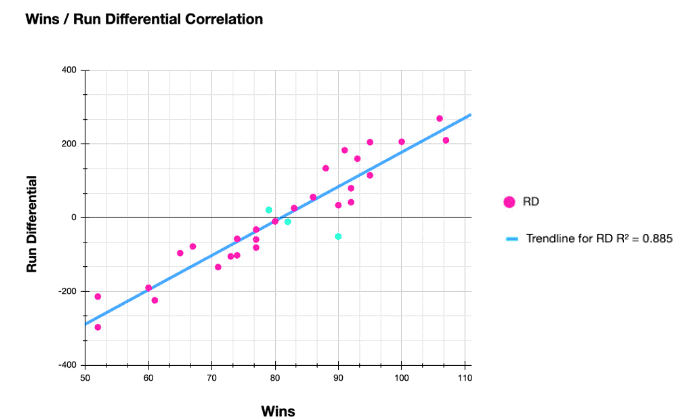In determining a team’s overall talent in baseball, there’s a system of computation that determines exactly that, but in a quantifiable form. This is called the RDiff baseball stat, more commonly known as a run differential.
What is run differential in baseball? FIY, it pertains to the calculation of runs scored by a team minus the runs they allowed for other teams to score, be it earned or unearned. This statistic helps determine which teams are doing fine or not.
Contents
Run Differential Definition
Statistics, numbers, and standings matter a lot when we talk about sports, especially in baseball where the teams’ prowess heavily depends on the numbers they produce in different skill categories.
In this article, we will answer the question “What does run differential mean in baseball?”
In the simplest Rdiff baseball meaning, this is a team’s statistical combination for both the offense and defense scoring. In different blogs or websites, you may notice the term “run differential” when talking about team standings, and this is what RDiff stands for in baseball.
How Do MLB Standings Run Differential Work? What is It Used for?
Mathematical operations are a source of everyone’s headaches. However, run differentials are computed more simpler than you imagined.
As we know what Rdiff means in baseball, it’s beneficial to learn how it works.
Well, run differentials work by subtracting the total runs allowed by a team against their opponent from their total runs scored.
More than the teams’ win-loss record, run differentials are a great way to determine a team’s overall talent and performance based on the runs they have made. This may even be considered a better indicator of which teams are more dominant than others and which teams may struggle throughout the league.
Pros and Cons
The main advantage of run differential in baseball is that it predicts a team’s standing and winnability in the incoming games more than what win-loss records show. In many instances, this is a great way to describe just how good or bad a team is doing in relation to the runs they scored.
However, although run differential is easy to maneuver, this statistical system is considered flawed for the following reasons:
- It is in favor of the high-scoring teams more than the low-scoring ones;
- And run differentials are a statistical outgrowth.
How to Calculate Run Differential in Baseball
The MLB run differential per game is a simpler formula derived from the Pythagorean Theorem of Baseball which was formulated by Bill James.
Given the formula above which is *total runs scored – total runs allowed*, we can get an idea of how an MLB team stats run differential is computed by using this example below from the American League West dated back in 1999:
Run Differential Calculator
| Teams | Run scored | Runs allowed | Run differential |
| Texas Rangers | 945 RS | 859 RA | 86 RDiff |
| Anaheim Angels | 711 RS | 826 RA | -115 RDiff |
| Seattle Mariners | 859 RS | 905 RA | -46 RDiff |
| Oakland Athletics | 893 RA | 846 RA | 47 RDiff |
Consequently, in a 2021 statistic, it was revealed that limiting runs from an opposing team is more crucial than scoring runs by the team themselves.
On a bigger scale of things, it was also revealed that the wins tallied by the teams are correlated to their run differential. The more wins, the higher the MLB standings run differential.
Case in point, this team standings in 2021 have proven the correlation between the number of wins and calculated run differential:
Largest Run Differential MLB Season
When we talk about statistics, there’s a lot of that in baseball. Let’s start with what team holds the largest run differential in an MLB season.
The St. Louis Maroons hold the feat of the largest run differential in a season in the MLB back in 1884. They have achieved this feat by scoring a total of 887 runs and have only allowed 429 to be scored by the opponents. Their run differential stands at +458.
Consequently, the highest run differential in a single MLB game has been clinched by the Cubs in 1987 with a total RDiff of +29. When we talk about baseball’s modern era of this feat, the Texas Rangers is the team to call after having a run differential of +27 in 2007.
It’s also worth noting that the 1998 Yankees’ run differential was nothing more than astonishing when they finished with a +309 run differential. That team was a perfect balance of what it meant to close out games on top.
And finally, in the current year of 2023, the Dodgers’ run differential stands at +22, topping the list amongst all other MLB teams for the season.
Worst Run Differential in MLB History
In 1899, the Cleveland Spiders recorded the worst run differential in history. During their time, they have tallied only 529 runs while allowing their opponents to score a total of 1252 runs against them.
These statistics have then caused the team to have a final run differential of -723, thus, being named as the worst run differential holder.
When we talk about the modern era of baseball, the Boston Red Sox of the year 1932 topped the list with a record of -349 run differential.
Frequently Asked Questions
Is a higher or lower run differential better?
Generally, a higher run differential is always better than a low one. Given that MLB run differentials will show a team’s total run scored minus the total runs given up, this statistic will reveal a lot about a team’s standing against the other teams and in the overall league.
Run differentials, especially higher ones, will determine whether or not a team could constantly sustain its standing throughout the season. On the other hand, lower run differentials will tell whether or not a team would be able to get out of a slump and stage a breakout game in the league.
Does run differential matter in MLB?
In some baseball leagues, run differentials matter to break up tie records between two or more opposing teams.
However, the Major League Baseball (MLB) run differential record does not serve as a basis for breaking equal records in the league.
Although run differentials weigh little to no importance in determining a team’s post-season berth, this statistic is still displayed on MLB’s official website for the reader to know the standings of their favorite teams.
Simply put, run differentials are a convenient way to dissect a team’s standings, but they do not hold value in breaking ties between teams.
Who has the best run differential?
In all of baseball history, the New York Yankees have had the best MLB run differential of all time at +411 in 1939. Meanwhile, the Boston Red Sox have scored the worst run differential at -349 in 1932.
What do RA, RS, and RD stand for in baseball?
As we already mentioned, RD is Run Different while RA stands for Run Average. RS, on the other hand, means a team’s Run Scored.
Conclusion
Watching baseball being played through motions gives us a sense of fulfillment and enjoyment, but knowing the statistics beneath all the moving players and stances take our experience to a whole nother level. While it’s fun to watch everyone’s groove on the field, the numbers take us to a more in-depth understanding of the sport.
This is why I brought forth the article “what is run differential in baseball?”, to be able to share with all of you how this area of the sport is calculated and why it’s an important piece of the sport.
I’ll see you next time!

A powerful swing and the ball is flying across the field, just one hit, and we might never forget the thrill it brings. I do not know about you, but I never do. Every baseball game is the chance to compete with others and cooperate with your teammate. It is among my biggest passions.



















